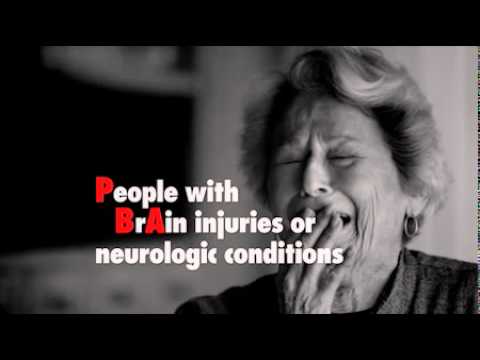What is Pseudobulbar affect (PBA)?
PBA is a condition that causes uncontrollable crying and/or laughing that happens suddenly and frequently. It can happen in people with a brain injury or certain neurologic conditions.
A person having a PBA crying spell may cry when they don’t feel sad or when they only feel a little bit sad. Someone having a PBA laughing spell may laugh when they don’t feel amused or when they only feel a little bit amused.
It is believed to involve injury to the neurological pathways that regulate the external expression of emotion (affect).
PBA has also been called:
- Emotional incontinence
- Emotional lability
- Involuntary crying
- Pathological laughing and crying
What is the Difference Between Pseudobulbar affect and Depression?
PBA is a Neurological response. This signifies damage to the nervous system. This means you have a Neurologic condition or brain injury.
Conditions like Depression are Psychological. This means they are related to a person’s mental and emotional state and you may or may not have an additional neurologic condition or brain injury.
It is possible to have PBA and Depression at the same time. However, the two are very separate conditions and should be diagnosed and managed separately.
A person having PBA may cry suddenly and frequently when they don’t feel sad, or when they only feel a little bit sad. This crying is uncontrollable and lasts from a few seconds to a few minutes. This can happen multiple times (frequently).
to a few minutes. This can happen multiple times (frequently).
[with depression – you may or may not have crying, you may be able to control your crying, your crying matches exactly how you are feeling]
Someone having a PBA laughing spell may laugh when they don’t feel amused or when they only feel a little bit amused. They may laugh frequently at inappropriate times. This laughter is uncontrollable and can also last from a few seconds to a few minutes. This can also happen multiple times (frequently). In PBA laughter often quickly turns to tears.
With PBA the emotions are exaggerated and do not necessarily match how the person actually feels.
Episodes may also be mood-incongruent: a patient might laugh uncontrollably when angry or frustrated, for example.
[with depression – crying is part of the depression and can last weeks to months]
In a person with PBA, they appear normal between episodes, which can happen at any time. The emotional responses typically represent a change from how they would have previously responded.
Emotional lability itself is also a component of pseudobulbar affect. Not only do the patients show exaggerated emotion, but they also feel more emotional, and they may show emotion even when they do not feel it. They appear to be out of control or more sensitive than they would like to been seen.
What Neurological Conditions cause Pseudobulabar affect?
- Traumatic Brain Injuries (TBI)/ head trauma
- Alzheimers/Dementia
- Stroke (CVA) – [PBA is most frequently reported post stroke behavior conditions]
- Multiple Sclerosis (MS)
- Lou Gehrig’s Disease (ALS)
- Parkinson’s Disease

- Brain Tumors
PBA can often be mistaken or misdiagnosed for other states or conditions such as:
- Adjustment disorder, personality disorder, or depression
- Bipolar disorder (associated with mood swings)
- Euphoria – Excessive laughter sometimes associated with conditions like multiple sclerosis (MS)
- PTSD – (post-traumatic stress disorder) – A disorder that follows a traumatic event, sometimes associated with conditions like traumatic brain injury (TBI)
- Pain (feeling sometimes communicated through crying, especially in people with Alzheimer’s disease)
- Epilepsy
- Schizophrenia
What are the complications of having Pseudobulbar affect?
Severe symptoms can cause embarrassment, social isolation, anxiety and depression. The condition might interfere with your ability to work and do daily tasks, especially when you’re already coping with a neurological condition.
Those with PBA have a higher prevalence of anxiety symptoms and poorer social functioning. PBA has been noted to interfere with the progress of rehabilitation. Neurological disorders associated with PBA are life-changing conditions which often have a substantial emotional impact on the patient and their families.
What treatments are available for PBA?
There’s no cure for PBA. But in cases where the underlying problem is addressed or improves – such as where a person gets noticeably better following a stroke or a brain injury – the awkward outbursts may cease to be as pronounced or occur less often, and medication may also help a person regain control of his or her emotions.
The goal of treatment of PBA is to diminish the severity and frequency of episodes.
Antidepressants for the treatment of PBA are typically prescribed at doses lower than are those used to treat depression. Antidepressants, such as tricyclic antidepressants (TCAs) and selective serotonin reuptake inhibitors (SSRIs), can help reduce the frequency and severity of PBA episodes.
Dextromethorphan hydrobromide and quinidine sulfate (Nuedexta) is the only medication currently approved by the Food and Drug Administration (FDA) that is designed to specifically treat PBA. A study on people with MS and ALS showed that those taking the medication had only about half as many laughing and crying episodes as did those taking the placebo.
When determining which treatment to select, the clinician must consider tolerance and the potential for adverse effects as major factors. TCAs, with their broad effects on monoaminergic, cholinergic, and histaminergic neurotransmission, may produce a wide range of side effects including dry mouth, constipation, orthostatic hypotension, confusion, sedation, and potential cardiotoxicity.
An occupational therapist also can help you develop ways to complete everyday tasks despite your PBA.
How is PBA diagnosed?
 Only a healthcare provider can diagnose PBA. However, the Center for Neurologic Study-Lability Scale (CNS-LS), developed by healthcare professionals, can help you assess whether you have symptoms of PBA.
Only a healthcare provider can diagnose PBA. However, the Center for Neurologic Study-Lability Scale (CNS-LS), developed by healthcare professionals, can help you assess whether you have symptoms of PBA.
PBA Diagnostic Assessment Scale – PDF
Is it possible for PBA to go away?
If its acquired during the early stages of a stroke or brain trauma, you generally get better and it could disappear completely in a couple of months to two years. However, if you still have it after three years, you are most likely going to have it permanently.
For other neurological disorders like Parkinson’s, Alzheimer’s, and Multiple Sclerosis, it usually worsens over time until your brain has no more connections left to even create a smile.
References
PBA INFO.ORG
National Institute of Health – PBA
Stroke.org – PBA
WebMD – Psuedobulbar Affect
US NEWS – Regaining Emotional Control
Neurology Times – Pseudobulbar Affect
VICE – Neurological Disorders
Thank you for visiting the HOPE TBI Website.
Please take the time to make a comment, share your thoughts, and tell us what impacted you the most and what brought you here:
https://hopetbi.com/reviews-and-testimonials/
Your input is important to the development and growth of this website, and we like to know what is going on out there in your thoughts.
Thank you for visiting us! We look forward to hearing from you.









I have pseudobulbar effect after having exploratory brain surgery for my epilepsy, and a faulty Vagal Nerve Stimulator (VNS) which shocked the hell out of me twice. This was all after a severe TBI received when I was 13. Now my emotions are released at their greatest potential when they happen, especially Anger, and it’s quite embarrassing
LikeLiked by 1 person
Greatest potential emotions induced by medical experiences are often attended with embarrassment, confusion, and often misunderstanding. Thank you for sharing your experience.
LikeLike
The research scientists Can’t cure “Chronic Fatigue Syndrome”/ME,either… 😦 Or alzheimer’s/demetia,etc,etc,Either… 😦 – Not enough money spent by government’s!!… 😦
LikeLike